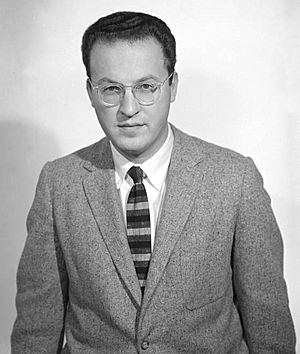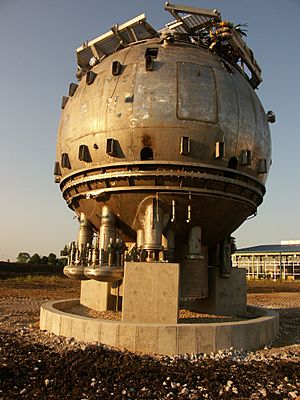Donald A. Glaser facts for kids
Quick facts for kids
Donald A. Glaser
|
|
|---|---|

Glaser in 1960
|
|
| Born |
Donald Arthur Glaser
September 21, 1926 Cleveland, Ohio, U.S.
|
| Died | February 28, 2013 (aged 86) Berkeley, California, U.S.
|
| Alma mater |
|
| Known for |
|
| Spouse(s) |
|
| Awards |
|
| Scientific career | |
| Fields | Physics, Molecular biology |
| Institutions | |
| Thesis | The momentum distribution of charged cosmic ray particles near sea level (1949) |
| Doctoral advisor | Carl David Anderson |
Donald Arthur Glaser (September 21, 1926 – February 28, 2013) was an American physicist and neurobiologist. He won the 1960 Nobel Prize in Physics. He received this award for inventing the bubble chamber. This special device helps scientists study tiny subatomic particles.
Contents
Early Life and Education
Donald Glaser was born on September 21, 1926, in Cleveland, Ohio. His parents were Lena and William J. Glaser. He loved music and played the piano, violin, and viola. He went to Cleveland Heights High School. There, he became very interested in physics. He wanted to understand how the physical world works.
He studied at Case School of Applied Science (now Case Western Reserve University). In 1946, he earned his bachelor's degree in physics and mathematics. He was especially interested in particle physics. He also played viola in the Cleveland Philharmonic.
Glaser then went to the California Institute of Technology (Caltech). He earned his PhD in physics in 1949. At Caltech, he worked with Nobel laureate Carl David Anderson. They studied cosmic rays using cloud chambers. Glaser learned to design and build his own experiment equipment. This skill was very helpful throughout his career.
After Caltech, Glaser became an instructor at the University of Michigan in 1949. He became a full professor there in 1957. In 1959, he joined the University of California at Berkeley as a Professor of Physics.
The Bubble Chamber
While teaching at the University of Michigan, Glaser started working on a new invention. He wanted a better way to study tiny, short-lived particles. Cloud chambers, which were used at the time, had problems. They used gas, and metal plates blocked the view. Also, they took too long to reset between experiments.
Glaser's idea was to use a superheated liquid in a glass chamber. When charged particles passed through this liquid, they would leave a trail of bubbles. These bubble trails could then be photographed. He built his first bubble chamber using ether. He later found that hydrogen also worked well.
There's a fun story that Glaser got the idea from bubbles in a glass of beer. He later said that beer wasn't the inspiration. But he did use beer to test some of his early models!
His new invention was perfect for use with high-energy particle accelerators. Glaser took his bubble chamber to Brookhaven National Laboratory. The clear images he created showed how important his device was. He received funding to build even larger chambers. In 1959, he moved to the University of California at Berkeley. There, he worked with Nobel laureate Luis Walter Alvarez, who was also building a hydrogen bubble chamber.
Nobel Prize and Other Awards
In 1960, Donald Glaser won the Nobel Prize in Physics. He received it for inventing the bubble chamber. His invention allowed scientists to see what happens to high-energy particles. This led to many important discoveries in physics.
He also received other honors:
- Elliott Cresson Medal (1961)
- Elected to the National Academy of Sciences (1962)
- Golden Plate Award of the American Academy of Achievement (1989)
- Elected to the American Philosophical Society (1997)
- Elected to the American Academy of Arts and Sciences (2003)
Switching to Molecular Biology
After winning the Nobel Prize, Glaser decided to explore a new field. He felt that physics experiments were becoming too large and costly. He wanted to focus more on science itself, not just managing big projects.
He remembered his interest in molecular genetics from his time at Caltech. So, he began to study biology. He spent time at MIT and in Copenhagen learning about biology.
Glaser explained that he had spent the first part of his life studying the physical world. Now, he wanted to understand the basis of life itself. He even joked that a famous scientist from the past, Louis Pasteur, would feel at home in a modern biology lab. Glaser then started creating equipment to automate biological processes.
He worked at UC Berkeley's Virus Lab. He did experiments with phages (viruses that infect bacteria), bacteria, and mammalian cells. He studied how cancer cells develop, especially a skin cancer called xeroderma pigmentosum. Just like with the bubble chamber, he used his engineering skills to improve experiments. He built a machine called the "dumbwaiter" to automate tasks like pouring agar and counting cell colonies.
Starting Companies
While still at UC Berkeley, Glaser started a company called Berkeley Scientific Laboratory in 1968. It worked on automating medical tests.
In 1971, he co-founded Cetus Corporation. This company aimed to use new knowledge about DNA to solve real-world problems. Cetus was a pioneer in the field of biotechnology. It focused on improving microbes and later on genetic engineering. Cetus was bought by Chiron Corporation in 1991.
Later Work in Neurobiology
As molecular biology became more about chemistry, Glaser thought about another career change. His experience with automating visual tasks in physics and biology led him to study human vision. He became interested in how the brain processes what we see. He started working on computer models of the visual system.
Personal Life
Donald Glaser died in his sleep on February 28, 2013, in Berkeley, California. He was 86 years old. He was survived by his wife, Lynn Glaser, his daughter, Louise Glaser, and his son, William Glaser. He also had several grandchildren.
See also
 In Spanish: Donald Glaser para niños
In Spanish: Donald Glaser para niños


